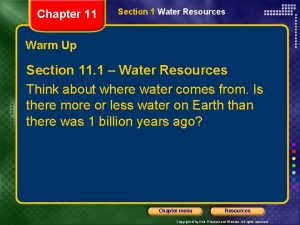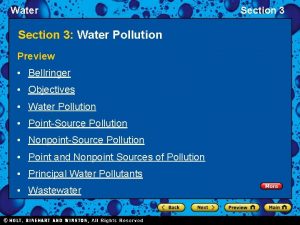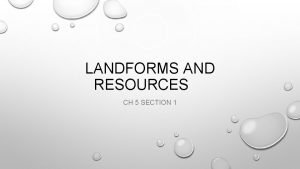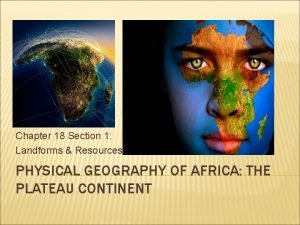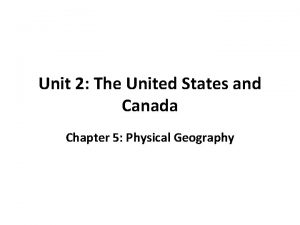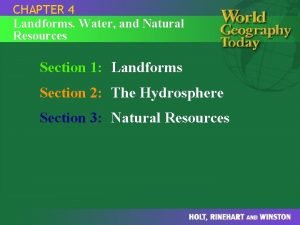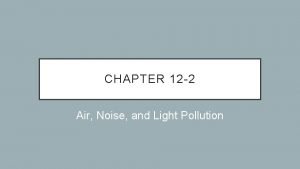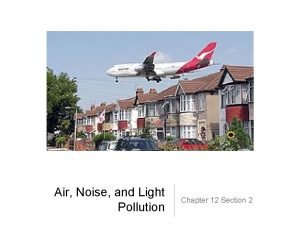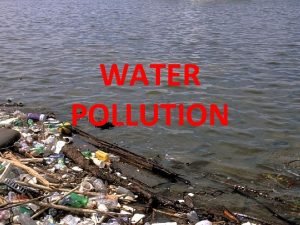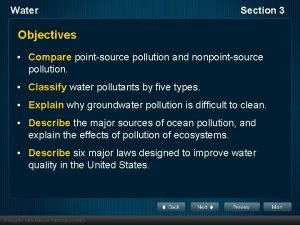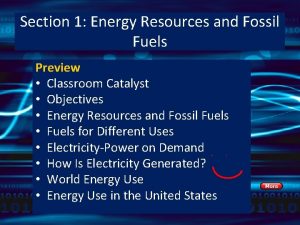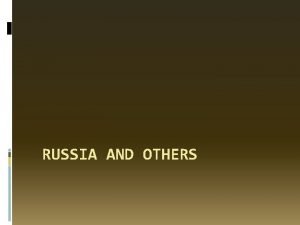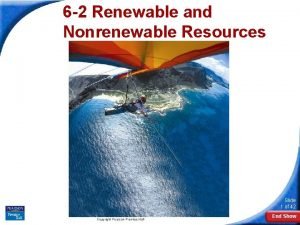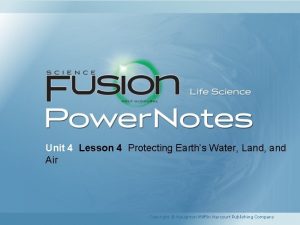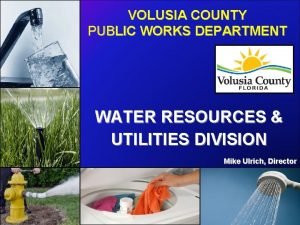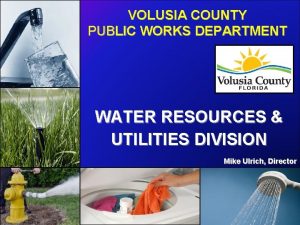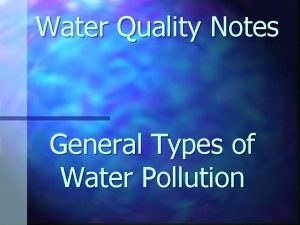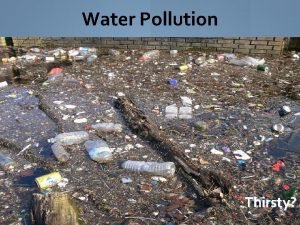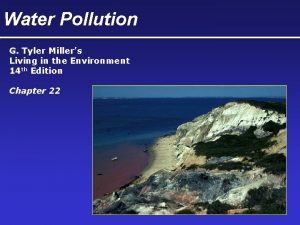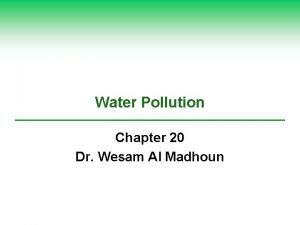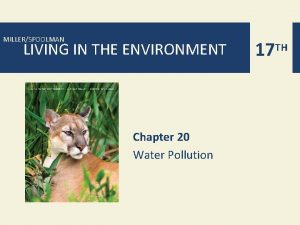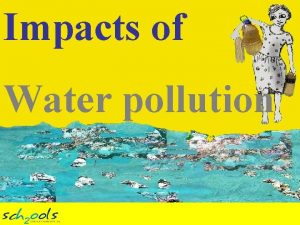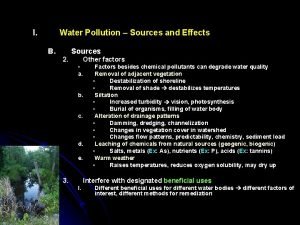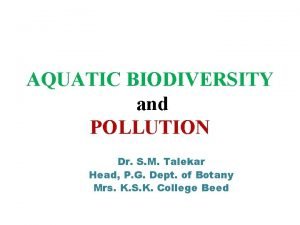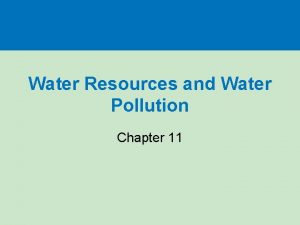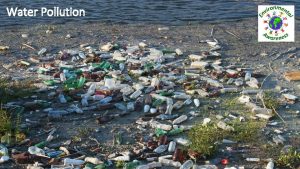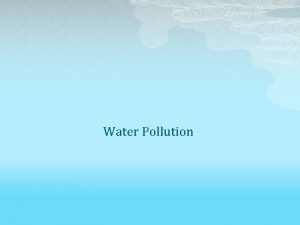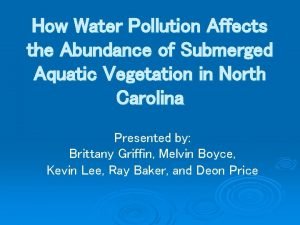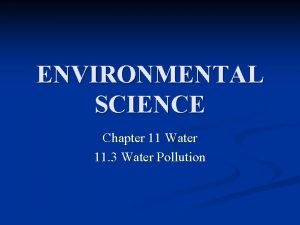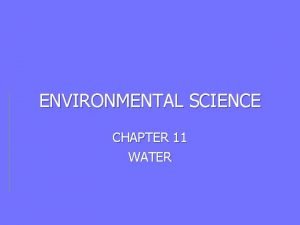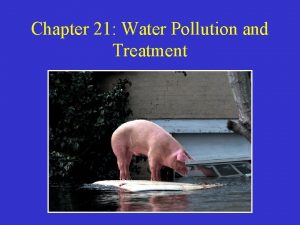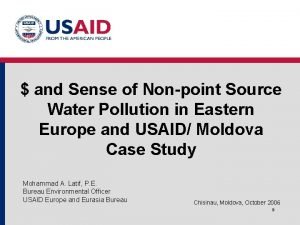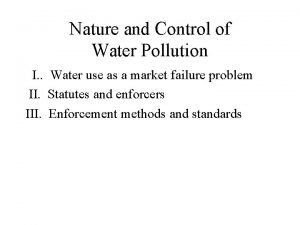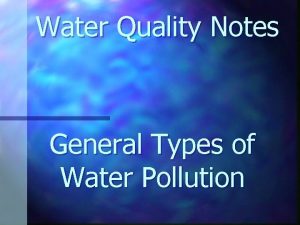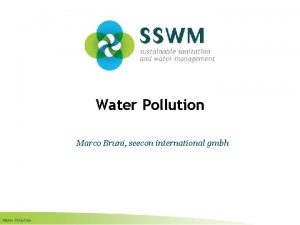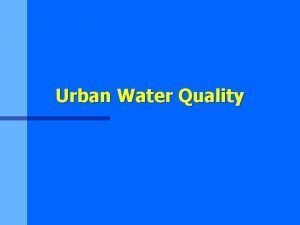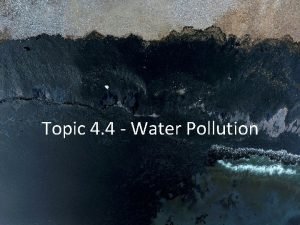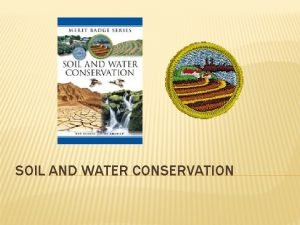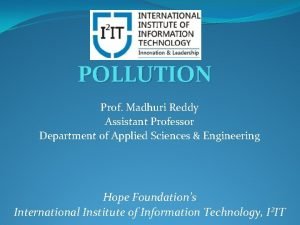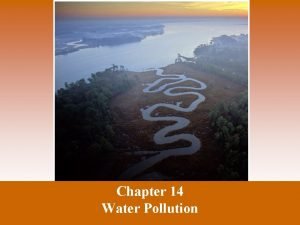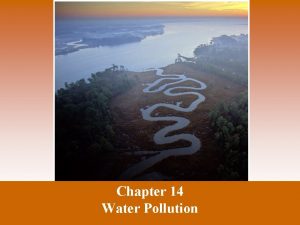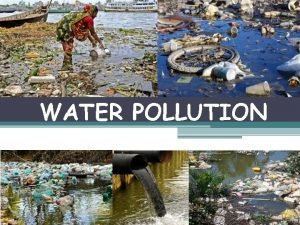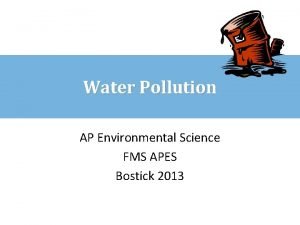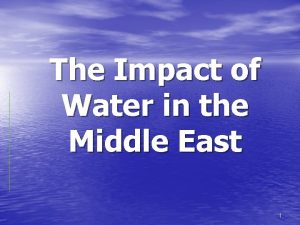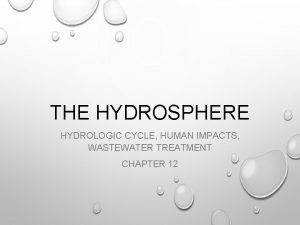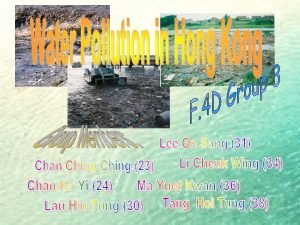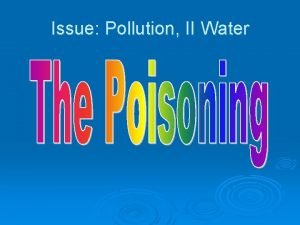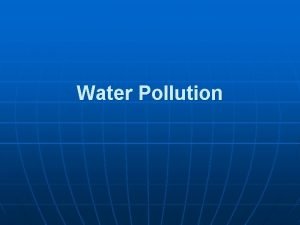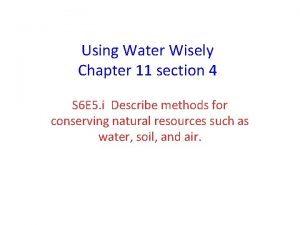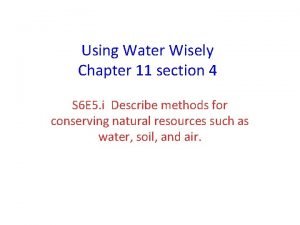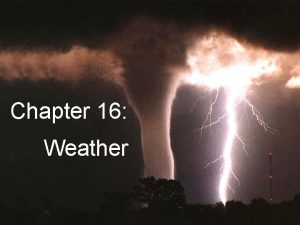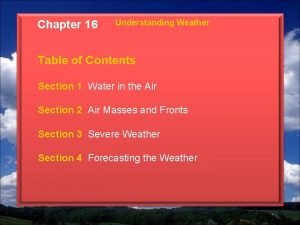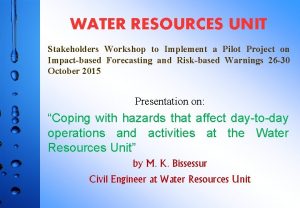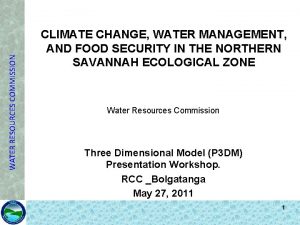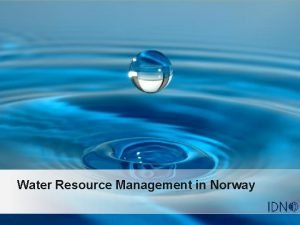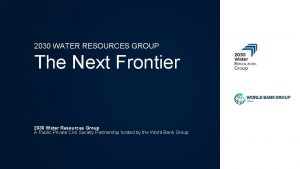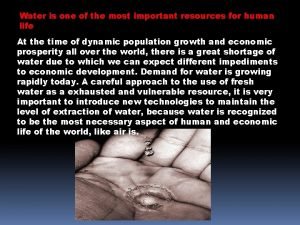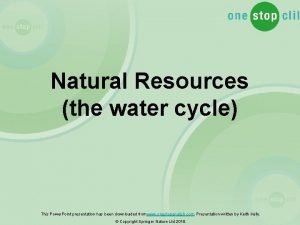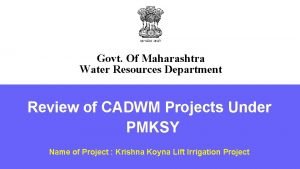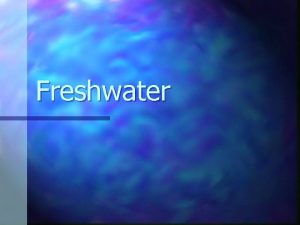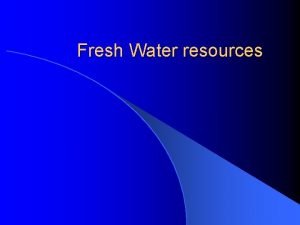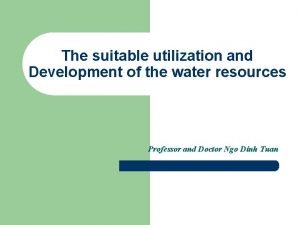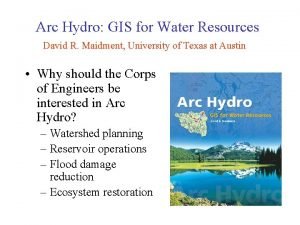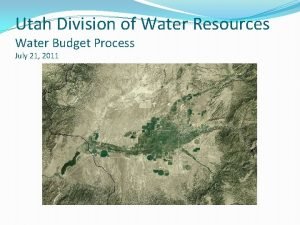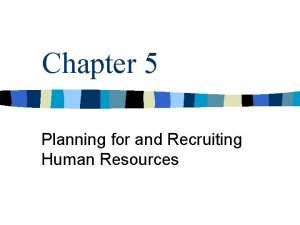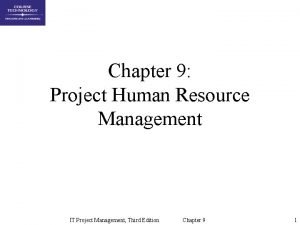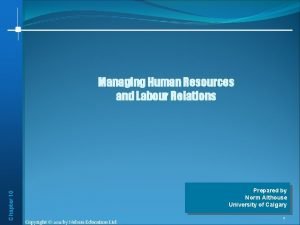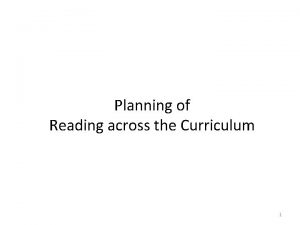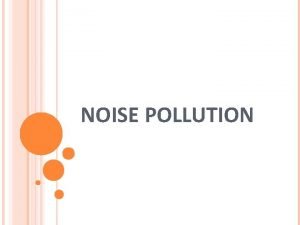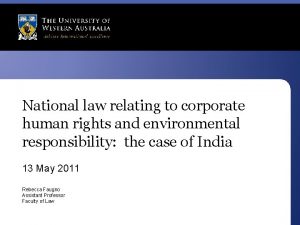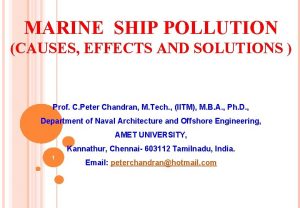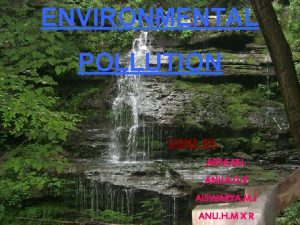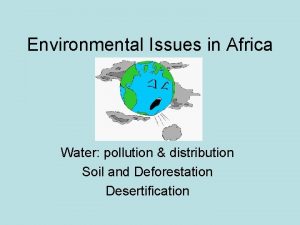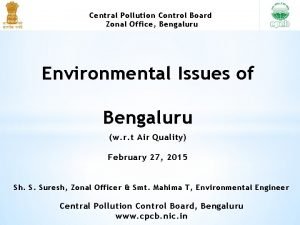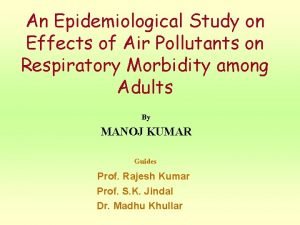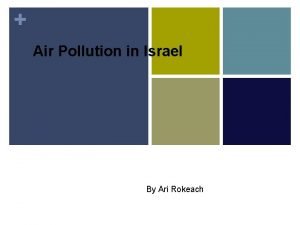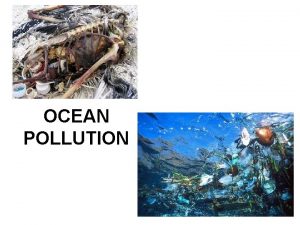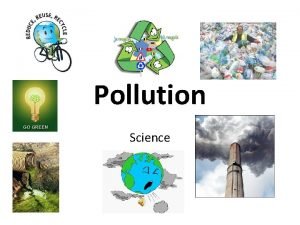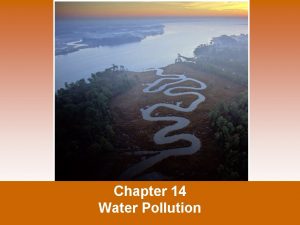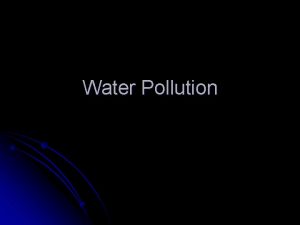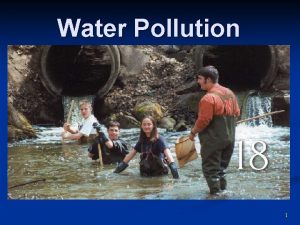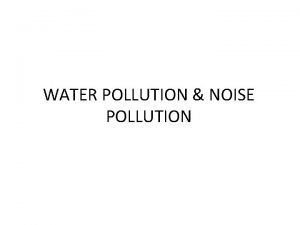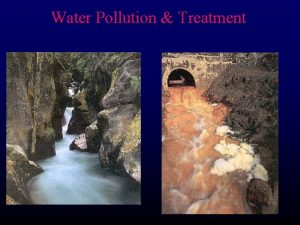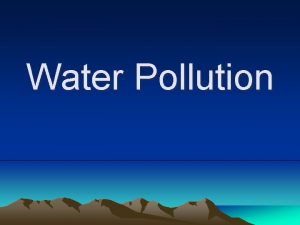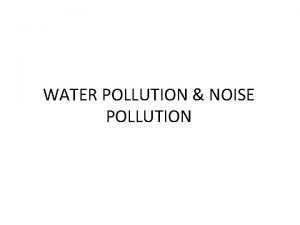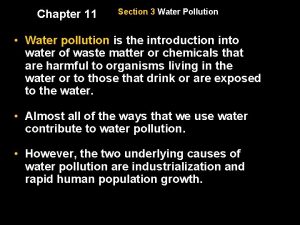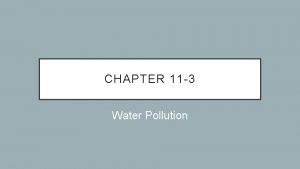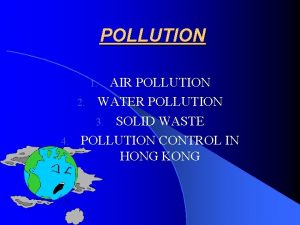Water Resources and Water Pollution Chapter 11 Section

























































































































- Slides: 121

Water Resources and Water Pollution Chapter 11

Section 11 -1 WILL WE HAVE ENOUGH USABLE WATER?

Freshwater is an irreplaceable resource that we are managing poorly • Freshwater is relatively pure and contains few dissolved salts. • Earth has a precious layer of water—most of it saltwater—covering about 71% of the earth’s surface. • Water is an irreplaceable chemical with unique properties that keep us and other forms of life alive. A person could survive for several weeks without food, but for only a few days without water.

Freshwater is an irreplaceable resource that we are managing poorly • Huge amounts of water are needed to supply us with food, shelter, and meet our other daily needs and wants. • Water helps to sculpt the earth’s surface, moderate climate, and remove and dilute wastes and pollutants. • Water is one of our most poorly managed resources. – People waste and pollute it. – We charge too little for making it available.

Freshwater is an irreplaceable resource that we are managing poorly • Concerns regarding water include: – Access to freshwater is a global health issue. Every day an average of 3, 900 children younger than age 5 die from waterborne infectious diseases. – An economic issue – vital for reducing poverty and producing food and energy. – A women’s and children’s issue in developing countries because poor women and girls often are responsible for finding and carrying daily supplies of water.

Freshwater is an irreplaceable resource that we are managing poorly – A national and global security issue because of increasing tensions within and between nations over access to limited water resources that they share. – An environmental issue because excessive withdrawal of water from rivers and aquifers results in dropping water tables, lower river flows, shrinking lakes, and losses of wetlands.

Most of the earth’s freshwater is not available to us • About 0. 024% is readily available to us as liquid freshwater in accessible groundwater deposits and in lakes, rivers, and streams. • The rest is in the salty oceans, in frozen polar ice caps and glaciers, or in deep underground and inaccessible locations.

Most of the earth’s freshwater is not available to us • The world’s freshwater supply is continually collected, purified, recycled, and distributed in the earth’s hydrologic cycle, except when: – Overloaded with pollutants. – We withdraw water from underground and surface water supplies faster than it is replenished. – We alter long-term precipitation rates and distribution patterns of freshwater through our influence on projected climate change.

Most of the earth’s freshwater is not available to us • Freshwater is not distributed evenly. – Differences in average annual precipitation and economic resources divide the world’s continents, countries, and people into water haves and have-nots. – Canada, with only 0. 5% of the world’s population, has 20% of the world’s liquid freshwater, while China, with 19% of the world’s people, has only 7% of the supply.

Groundwater and surface water are critical resources • Some precipitation infiltrates the ground and percolates downward through spaces in soil, gravel, and rock until an impenetrable layer of rock stops this groundwater—one of our most important sources of freshwater. – The zone of saturation is where the spaces are completely filled with water. – The top of this groundwater zone is the water table.

Groundwater and surface water are critical resources – Aquifers: underground caverns and porous layers of sand, gravel, or bedrock through which groundwater flows—typically moving only a meter or so (about 3 feet) per year and rarely more than 0. 3 meter (1 foot) per day. – Watertight layers of rock or clay below such aquifers keep the water from escaping deeper into the earth.

Groundwater and surface water are critical resources • Surface water is the freshwater from precipitation and snowmelt that flows across the earth’s land surface and into lakes, wetlands, streams, rivers, estuaries, and ultimately to the oceans. – Precipitation that does not infiltrate the ground or return to the atmosphere by evaporation is called surface runoff. – The land from which surface water drains into a particular river, lake, wetland, or other body of water is called its watershed, or drainage basin.

We use a large and growing portion of the world’s reliable runoff • Two-thirds of the annual surface runoff in rivers and streams is lost by seasonal floods and is not available for human use. – The remaining one third is reliable surface runoff, which we can generally count on as a source of freshwater from year to year. • During the last century, the human population tripled, global water withdrawals increased sevenfold, and per capita withdrawals quadrupled. We now withdraw about 34% of the world’s reliable runoff of freshwater.

We use a large and growing portion of the world’s reliable runoff • Worldwide, about 70% of the water we withdraw each year comes from rivers, lakes, and aquifers to irrigate cropland, industry uses another 20%, and residences 10%. • Affluent lifestyles require large amounts of water.

Freshwater shortages will grow • The main factors that cause water scarcity in any particular area are a dry climate, drought, too many people using a water supply more quickly than it can be replenished, and wasteful use of water. • More than 30 countries—mainly in the Middle East and Africa—now face water scarcity. • By 2050, 60 countries, many of them in Asia, with three-fourths of the world’s population, are likely to be suffering from water stress.

The world’s major river basins differ in their degree of freshwater-scarcity stress

Freshwater shortages will grow • In 2009, about 1 billion people in the world currently lack regular access to enough clean water for drinking, cooking, and washing. • By 2025, at least 3 billion people are likely to lack access to clean water. • We can increase freshwater supplies by: – withdrawing groundwater; building dams and reservoirs to store runoff in rivers for release as needed – transporting surface water from one area to another; and converting saltwater to freshwater (desalination) – reducing unnecessary waste of freshwater

Section 11 -2 HOW CAN WE INCREASE WATER SUPPLIES?

Groundwater is being withdrawn faster than it is replenished in some areas • Aquifers provide drinking water for nearly half of the world’s people. • Most aquifers are renewable resources unless their water becomes contaminated or is removed faster than it is replenished by rainfall. • Water tables are falling in many areas of the world because the rate of pumping water from aquifers (mostly to irrigate crops) exceeds the rate of natural recharge from rainfall and snowmelt.

Groundwater is being withdrawn faster than it is replenished in some areas • The world’s three largest grain producers—China, India, and the United States—as well as Mexico, Saudi Arabia, Iran, Yemen, Israel, and Pakistan are overpumping many of their aquifers.

Withdrawing groundwater has advantages and disadvantages

Irrigation in Saudi Arabia between 1986 (left) and 2004 (right)

Groundwater overdrafts in the United States

Overpumping of aquifers has several harmful effects • As water tables drop, farmers must drill deeper wells, buy larger pumps, and use more electricity to run those pumps. Poor farmers cannot afford to do this and end up losing their land. • Withdrawing large amounts of groundwater causes the sand rock in aquifers to collapse. – This causes the land above the aquifer to subside or sink (land subsidence), referred to as a sinkhole. – Once an aquifer becomes compressed by subsidence, recharge is impossible. – In addition, land subsidence can damage roadways, water and sewer lines, and building foundations.

Overpumping of aquifers has several harmful effects • Groundwater overdrafts near coastal areas can pull saltwater into freshwater aquifers. The resulting contaminated groundwater is undrinkable and unusable for irrigation. • Deep water aquifers hold enough freshwater to support billions of people for centuries. • Concerns about tapping these ancient deposits of freshwater: – They are nonrenewable and cannot be replenished on a human timescale.

Overpumping of aquifers has several harmful effects – Little is known about the geological and ecological impacts of pumping large amounts of freshwater from deep aquifers. – Some deep aquifers flow beneath more than one country and there are no international treaties that govern rights to them. Without such treaties, water wars could break out. – The costs of tapping deep aquifers are unknown and could be high.

Subsidence from overpumping

Solutions for groundwater depletion

Large dams and reservoirs have advantages and disadvantages • Dams are structures built across rivers to block some of the flow of water. • Dammed water usually creates a reservoir, a store of water collected behind the dam. • A dam and reservoir: – capture and store runoff and release it as needed to control floods. – generate electricity (hydroelectricity).

Large dams and reservoirs have advantages and disadvantages – supply water for irrigation and for towns and cities. – provide recreational activities such as swimming, fishing, and boating. • The world’s 45, 000 large dams have increased the annual reliable runoff available for human use by nearly 33%. • Negative effects of dams include: – displaced 40– 80 million people from their homes.

Large dams and reservoirs have advantages and disadvantages – flooded an area of mostly productive land totaling roughly the area of California. – impaired some of the important ecological services that rivers provide. • Reservoirs eventually fill up with sediment, typically within 50 years, eventually making them useless for storing water or producing electricity. • Around 500 small dams have been removed in the U. S. but removal of large dams is controversial and expensive.

Large dams and reservoirs have advantages and disadvantages

Provides irrigation water above and below dam Provides water for drinking Reservoir useful for recreation and fishing Can produce cheap electricity (hydropower) Reduces downstream flooding of cities and farms Flooded land destroys forests or cropland displaces people Large losses of water through evaporation Deprives downstream cropland estuaries of nutrient-rich silt Risk of failure and devastating downstream flooding Disrupts migration and spawning of some fish Fig. 11 -12 a, p. 247

A closer look at the overtapped Colorado River basin • The amount of water flowing to the mouth of the heavily dammed Colorado River has dropped dramatically. • In most years since 1960, the river has dwindled to a small, sluggish stream by the time it reaches the Gulf of California. • Negative effects include that: – As the flow of the rivers slows in reservoirs, it drops much of its load of suspended silt, depriving the river’s coastal delta of much-needed sediment and causing flooding and loss of ecologically important coastal wetlands.

A closer look at the overtapped Colorado River basin – These reservoirs will probably become too full of silt to control floods and store enough water for generating hydroelectric power, or to provide freshwater for irrigation and drinking water for urban areas. – Agricultural production would drop sharply and many people in the region’s cities likely would have to migrate to other areas. – Withdrawing more groundwater from aquifers is not a solution, because water tables are already low and withdrawals threaten the survival of aquatic species that spawn in the river, and destroy estuaries that serve as breeding grounds for numerous other aquatic species.

Since 1905, the amount of water flowing to the mouth of the Colorado River has dropped dramatically

Water transfers can be wasteful and environmentally harmful • In many cases, water has been transferred into various dry regions of the world for growing crops and for other uses. • Such water transfers have benefited many people, but they have also wasted a lot of water and they have degraded ecosystems from which the water was taken. • Such water waste is part of the reason why many products include large amounts of virtual water.

Removing salt from seawater is costly, kills marine organisms, and produces briny wastewater • Desalination involves removing dissolved salts from ocean water or from brackish water in aquifers or lakes for domestic use. – Distillation involves heating saltwater until it evaporates (leaving behind salts in solid form) and condenses as freshwater. – Reverse osmosis (or microfiltration) uses high pressure to force saltwater through a membrane filter with pores small enough to remove the salt.

Removing salt from seawater is costly, kills marine organisms, and produces briny wastewater • Today, about 13, 000 desalination plants operate in more than 125 countries, especially in the arid nations of the Middle East, North Africa, the Caribbean, and the Mediterranean. • There are three major problems with the widespread use of desalination – The high cost, because it takes a lot of increasingly expensive energy to desalinate water. – Pumping large volumes of seawater through pipes and using chemicals to sterilize the water and keep down algae growth kills many marine organisms and also requires large inputs of energy to run the pumps.

Removing salt from seawater is costly, kills marine organisms, and produces briny wastewater – Desalination produces huge quantities of salty wastewater that must go somewhere. • Some scientists have hopes for using solar energy as the primary power source for desalination.

Section 11 -3 HOW CAN WE USE FRESHWATER MORE SUSTAINABLY?

Reducing freshwater waste has many benefits • An estimated 66% of the freshwater used in the world is unnecessarily wasted. • In the United States—the world’s largest user of water—about half of the water drawn from surface and groundwater supplies is wasted. • It is economically and technically feasible to reduce such water losses to 15%, thereby meeting most of the world’s water needs for the foreseeable future.

Reducing freshwater waste has many benefits • Reasons so much freshwater is wasted: – Government subsidies that keep the cost of freshwater low. – Lack of government subsidies for improving the efficiency of freshwater use.

We can cut freshwater waste in irrigation • About 60% of the irrigation water worldwide does not reach the targeted crops. • In most irrigation systems, water is pumped from a groundwater or surface water source through unlined ditches and about 40% is lost through evaporation, seepage, and runoff. • Flood irrigation delivers far more water than needed for crop growth and typically loses 40% of water through evaporation, seepage, and runoff. • With existing irrigation, could be reduced to 5– 10%.

Ways to reduce freshwater waste in irrigation

We can cut freshwater waste in industry and homes • Producers of chemicals, paper, oil, coal, primary metals, and processed food consume almost 90% of the water used by industry in the United States. • Some of these industries recapture, purify, and recycle water to reduce their water use and water treatment costs. • Most industrial processes could be redesigned to use much less freshwater.

We can cut freshwater waste in industry and homes • Flushing toilets with freshwater is the largest use of domestic water in the US. – Standards have required that new toilets use no more than 6. 1 liters (1. 6 gallons) of water per flush. • Studies show that 30– 60% of the freshwater supplied in nearly all of the world’s major cities in less-developed countries is lost, primarily through leakage in water mains, pipes, pumps, and valves.

We can cut freshwater waste in industry and homes • Fixing leaks should be a high government priority, would cost less than building dams or importing water. • Homeowners and businesses in water-short areas are using drip irrigation and replacing lawns with native plants that need little freshwater. • About 50– 75% of the slightly dirtied water from bathtubs, showers, sinks, dishwashers, and clothes washers in a typical house could be stored in a holding tank and then reused as gray water to irrigate lawns and nonedible plants, to flush toilets, and to wash cars.

We can cut freshwater waste in industry and homes • The relatively low cost of water in most communities causes excessive water use and waste. – Many water utility and irrigation authorities charge a flat fee for water use, and some charge less for the largest users of water. – About one-fifth of all U. S. public water systems do not have water meters and charge a single low rate for almost unlimited use of high-quality water. – Many apartment dwellers have little incentive to conserve water, because water use charges are included in their rent.

We can cut freshwater waste in industry and homes

We can use less water to remove wastes • Large amounts of freshwater good enough to drink are being flushed away as industrial, animal, and household wastes. • Within 40 years we may need the world’s entire reliable flow of river water just to dilute and transport the wastes we produce each year. • Save water by using systems that mimic the way nature deals with wastes by recycling them. • Rely more on waterless composting toilets.

We need to use water more sustainably • Each of us can help bring about such a “blue revolution” by using and wasting less water to reduce our water footprints.

We need to use water more sustainably

Section 11 -4 HOW CAN WE REDUCE THREAT OF FLOODING?

Some areas get too much water from flooding • Some areas sometimes have too much water because of natural flooding by streams, caused mostly by heavy rain or rapidly melting snow. • A flood happens when water in a stream overflows its normal channel and spills into the adjacent area, called a floodplain. • Floodplains, which usually include highly productive wetlands, help to provide natural flood and erosion control, maintain high water quality, and recharge groundwater.

Some areas get too much water from flooding • People settle on floodplains to take advantage of their many assets, such as fertile soil, ample freshwater and proximity to rivers for transportation and recreation. • To reduce threat of flooding for people who live on floodplains: – Rivers have been narrowed and straightened (channelized), equipped with protective levees and walls, and dammed to create reservoirs that store and release water as needed. – Greatly increased flood damage may occur when prolonged rains overwhelm them.

Some areas get too much water from flooding • Floods provide several benefits. – Create the world’s most productive farmland by depositing nutrient-rich silt on floodplains. – Recharge groundwater and help to refill wetlands, thereby supporting biodiversity and aquatic ecological services. • Since the 1960 s, human activities have contributed to a sharp rise in flood deaths and damages, meaning that such disasters are partly human-made.

Some areas get too much water from flooding – Removal of water-absorbing vegetation, especially on hillsides, which can increase flooding and pollution in local streams, as well as landslides and mudflows. – Draining and building on wetlands, which naturally absorb floodwaters. • Hurricane Katrina struck the US Gulf Coast in August 2005 and contributed to the flooding of the city of New Orleans, Louisiana. Damage was intensified because of the degradation or removal of coastal wetlands that had historically helped to buffer the land from storm surges.

A hillside before and after deforestation

Tree plantation Diverse ecological habitat Evapotranspiration Trees reduce soil erosion from heavy rain and wind Agricultural land Tree roots stabilize soil Roads destabilize hillsides Evapotranspiration decreases Overgrazing accelerates soil erosion by water and wind Winds remove fragile topsoil Agricultural land is flooded and silted up Gullies and landslides Heavy rain erodes topsoil Vegetation releases water slowly and reduces flooding Forested Hillside Silt from erosion fills rivers and reservoirs Rapid runoff causes flooding After Deforestation Stepped Art Fig. 11 -20, p. 254

We can reduce flood risks • To improve flood control, we can rely less on engineering devices such as dams and levees and more on nature’s systems such as wetlands and natural vegetation in watersheds. • Channelization reduces upstream flooding, but: – It eliminates aquatic habitats, reduces groundwater discharge, and results in a faster flow, which can increase downstream flooding and sediment deposition. – Channelization encourages human settlement in floodplains, which increases the risk of damages and deaths from major floods.

We can reduce flood risks • Levees or floodwalls along the sides of streams contain and speed up stream flow, but they increase the water’s capacity for doing damage downstream. – No protection against unusually high and powerful floodwaters. – In 1993, two-thirds of the levees built along the Mississippi River were damaged or destroyed. • Dams can reduce threat of flooding by storing water in a reservoir and releasing it gradually, but they also have a number of disadvantages.

We can reduce flood risks • An important way to reduce flooding is to preserve existing wetlands and restore degraded wetlands to take advantage of the natural flood control they provide in floodplains. • We can sharply reduce emissions of greenhouse gases that contribute to projected climate change, which will likely raise sea levels and flood many coastal areas of the world during this century. • We can think carefully about where we choose to live. – Many poor people live in flood-prone areas because they have nowhere else to go. Most people, however, can choose not to live in areas especially subject to flooding or to water shortages.

Ways to reduce flood risk

Section 11 -5 HOW CAN WE DEAL WITH WATER POLLUTION?

Water pollution comes from point and nonpoint sources • Water pollution is any change in water quality that harms humans or other living organisms or makes water unsuitable for human uses such as drinking, irrigation, and recreation. – Point sources discharge pollutants at specific locations through drain pipes, ditches, or sewer lines into bodies of surface water. • Because point sources are located at specific places, they are fairly easy to identify, monitor, and regulate.

Water pollution comes from point and nonpoint sources – Nonpoint sources are broad, diffuse areas, rather than points, from which pollutants enter bodies of surface water or air. • Difficult and expensive to identify and control discharges from many diffuse sources. – Agricultural activities are the leading cause of water pollution, including sediment from erosion, fertilizers and pesticides, bacteria from livestock and food-processing wastes, and excess salts from soils of irrigated cropland.

Water pollution comes from point and nonpoint sources – Industrial facilities, which emit a variety of harmful inorganic and organic chemicals, are a second major source of water pollution. – Mining is the third biggest source of water pollution. Surface mining disturbs the land by creating major erosion of sediments and runoff of toxic chemicals.

Major water pollutants have harmful effects • According to the WHO, an estimated 4, 400 people die each day from preventable infectious diseases that they get from drinking contaminated water.

Major Water Pollutants and Their Sources

Streams can cleanse themselves, if we do not overload them • Flowing rivers and streams can recover rapidly from moderate levels of degradable, oxygen-demanding wastes through a combination of dilution and biodegradation of such wastes by bacteria. • This natural recovery process does not work when streams become overloaded with such pollutants or when drought, damming, or water diversion reduces their flows.

Streams can cleanse themselves, if we do not overload them • Laws enacted in the 1970 s to control water pollution have greatly increased the number and quality of plants that treat wastewater—water that contains sewage and other wastes from homes and industries—in the United States and in most other more-developed countries. • Laws also require industries to reduce or eliminate their point-source discharges of harmful chemicals into surface waters.

Streams can cleanse themselves, if we do not overload them • In most less-developed countries, stream pollution from discharges of untreated sewage, industrial wastes, and discarded trash is a serious and growing problem. • According to the World Commission on Water in the 21 st Century, half of the world’s 500 major rivers are heavily polluted, and most of these polluted waterways run through less-developed countries.

The oxygen sag curve (blue) and demand curve (red)

Point source Types of organisms Dissolved oxygen (ppm) n water Normal clea t, perch, rou organisms (T , stonefly) bass, mayfly utionent, Poll nt s b a h is F lera Pollutionsludge to s (carp, i, g n fu t fishe toleran worms, , rp a gar) (c fishes cteria a b gar) (anaerobic) n water Normal clea t, perch, rou organisms (T , stonefly) bass, mayfly 8 ppm al Biochemic n oxyge demand ne e n Clean Zo sition Decompo Zone Septic Zone Recovery Zone Clean Zo Fig. 11 -23, p. 258

Too little mixing and low water flow make lakes vulnerable to water pollution • Lakes and reservoirs are generally less effective at diluting pollutants than streams. – Deep lakes and reservoirs often contain stratified layers that undergo little vertical mixing. – Little or no flow. • Lakes and reservoirs are more vulnerable than streams to contamination by runoff or discharge of plant nutrients, oil, pesticides, and nondegradable toxic substances such as lead, mercury, and arsenic.

Too little mixing and low water flow make lakes vulnerable to water pollution • Many toxic chemicals and acids also enter lakes and reservoirs from the atmosphere. • Eutrophication refers to the natural nutrient enrichment of a shallow lake, estuary, or slowmoving stream usually caused by runoff of plant nutrients such as nitrates and phosphates from surrounding land. • An oligotrophic lake is low in nutrients and its water is clear.

Too little mixing and low water flow make lakes vulnerable to water pollution • Near urban or agricultural areas, human activities can greatly accelerate the input of plant nutrients to a lake (cultural eutrophication). – During hot weather or drought, this nutrient overload produces dense growths or “blooms” of organisms, such as algae and cyanobacteria, and thick growths of aquatic plants. • This dense plant life can reduce lake productivity and fish growth by decreasing the input of solar energy needed for photosynthesis by phytoplankton that support fish. • The algae die and decompose, providing food for aerobic bacteria, which deplete dissolved oxygen. Low oxygen then can kill fish and other aerobic aquatic animals.

Too little mixing and low water flow make lakes vulnerable to water pollution • Anaerobic bacteria can take over and produce gaseous products such as smelly, highly toxic hydrogen sulfide and flammable methane. – About one-third of the 100, 000 medium to large lakes and 85% of the large lakes near major U. S. population centers have some degree of cultural eutrophication. – Ways to prevent or reduce cultural eutrophication: • Advanced (but expensive) waste treatment to remove nitrates and phosphates before wastewater enters lakes.

Too little mixing and low water flow make lakes vulnerable to water pollution • Banning or limiting the use of phosphates in household detergents and other cleaning agents. • Employ soil conservation and land-use control to reduce nutrient runoff. – Ways to clean up lakes suffering from cultural eutrophication: • Mechanically remove excess weeds. • Control undesirable plant growth with herbicides and algaecides. • Pump air through lakes and reservoirs to prevent oxygen depletion.

Severe cultural eutrophication has covered this lake in China with algae

Groundwater cannot cleanse itself very well • Groundwater pollution is a serious threat to human health. • Common pollutants such as fertilizers, pesticides, gasoline, and organic solvents can seep into groundwater from numerous sources. • When groundwater becomes contaminated, it cannot cleanse itself of degradable wastes as quickly as flowing surface water does.

Groundwater cannot cleanse itself very well – Flows so slowly that contaminants are not diluted and dispersed effectively. – Low concentrations of dissolved oxygen and smaller populations of decomposing bacteria. – Usually colder so chemical reactions are slower. • It can take decades to thousands of years for contaminated groundwater to cleanse itself of slowly degradable wastes. • On a human time scale, nondegradable wastes remain in the water permanently.

Groundwater pollution is a serious hidden threat in some areas • Little is known about groundwater pollution because it is expensive to locate, track, and test aquifers. • Groundwater provides about 70% of China’s drinking water. • In 2006, the Chinese government reported that aquifers in about nine of every ten Chinese cities are polluted or overexploited, and could take hundreds of years to recover.

Groundwater pollution is a serious hidden threat in some areas • In the US, an EPA survey of 26, 000 industrial waste ponds and lagoons found that one-third of them had no liners to prevent toxic liquid wastes from seeping into aquifers. • Almost two-thirds of America’s liquid hazardous wastes are injected into the ground in disposal wells, some of which leak water into aquifers used as sources of drinking water. • By 2008, the EPA had completed the cleanup of about 357, 000 of 479, 000+ underground tanks in the US that were leaking gasoline, diesel fuel, home heating oil, or toxic solvents into groundwater.

Groundwater pollution is a serious hidden threat in some areas • During this century, scientists expect many of the millions of such tanks around the world to become corroded and leaky, possibly contaminating groundwater and becoming a major global health problem. • Determining the extent of a leak from a single underground tank can cost $25, 000– 250, 000, and cleanup costs range from $10, 000 to more than $250, 000. If the chemical reaches an aquifer, effective cleanup is often not possible or is too costly.

Principal sources of groundwater contamination in the U. S.

Polluted air Hazardous waste injection well Pesticides and fertilizers Coal strip mine runoff Deicing road salt Pumping well Gasoline station Waste lagoon Water pumping well Buried gasoline and solvent tanks Cesspool, septic tank Sewer Landfill Leakage from faulty casing Accidental spills Discharge Freshwater aquifer Groundwater flow Fig. 11 -26, p. 261

Pollution prevention is the only effective way to protect groundwater • Find substitutes for toxic chemicals. • Keep toxic chemicals out of the environment. • Install monitoring wells near landfills and underground tanks. • Require leak detectors on underground tanks. • Ban hazardous waste disposal in landfills and injection wells. • Store harmful liquids in aboveground tanks with leak detection and collection systems.

Ways to prevent and clean up contamination of groundwater

There are many ways to purify drinking water • Most of the more-developed countries have laws establishing drinking water standards. But most of the less-developed countries do not have such laws or, if they do have them, they do not enforce them. • More-developed countries usually store surface water in a reservoir to increasing dissolved oxygen content and allow suspended matter to settle, then pumped water to a purification plant and treat it to meet government drinking water standards.

There are many ways to purify drinking water • Very pure groundwater or surface water sources need little treatment. • Protecting a water supply is usually a lot cheaper than building water purification plants. • We have the technology to convert sewer water into pure drinking water. But reclaiming wastewater is expensive and it faces opposition from citizens and from some health officials who are unaware of the advances in this technology.

There are many ways to purify drinking water • Simple measures can be used to purify drinking water: – Exposing a clear plastic bottle filled with contaminated water to intense sunlight can kill infectious microbes in as little as three hours. – The Life Straw is an inexpensive portable water filter that eliminates many viruses and parasites from water drawn into it.

Ocean pollution is a growing and poorly understood problem • The oceans hold 97% of the earth’s water, make up 97% of the biosphere where life is found, and contain the planet’s greatest diversity and abundance of life. • Oceans help to provide and recycle the planet’s freshwater through the water cycle. They also strongly affect weather and climate, help to regulate the earth’s temperature, and absorb some of the massive amounts of carbon dioxide that we emit into the atmosphere • Coastal areas—especially wetlands, estuaries, coral reefs, and mangrove swamps—bear the brunt of our enormous inputs of pollutants and wastes into the ocean.

Ocean pollution is a growing and poorly understood problem – 80 -90% of municipal sewage from most coastal areas of less -developed countries, and in some coastal areas of moredeveloped countries, is dumped into oceans without treatment. – Some U. S. coastal waters have found vast colonies of viruses thriving in raw sewage and in effluents from sewage treatment plants and leaking septic tanks. – Scientists also point to the underreported problem of pollution from cruise ships. – Harmful algal blooms can result from the runoff of sewage and agricultural water. – Every year, because of harmful algal blooms, at least 400 oxygen-depleted zones form in coastal waters around the world.

Residential areas, factories, and farms all contribute to the pollution of coastal waters

Industry Nitrogen oxides from autos and smokestacks, toxic chemicals, and heavy metals in effluents flow into bays and estuaries. Cities Toxic metals and oil from streets and parking lots pollute waters; sewage adds nitrogen and phosphorus. Urban sprawl Bacteria and viruses from sewers and septic tanks contaminate shellfish beds and close beaches; runoff of fertilizer from lawns adds nitrogen and phosphorus. Construction sites Sediments are washed into waterways, choking fish and plants, clouding waters, and blocking sunlight. Closed shellfish beds Closed beach Oxygen-depleted zone Farms Runoff of pesticides, manure, and fertilizers adds toxins and excess nitrogen and phosphorus. Red tides Excess nitrogen causes explosive growth of toxic microscopic algae, poisoning fish and marine mammals. Toxic sediments Chemicals and toxic metals contaminate shellfish beds, kill spawning fish, and accumulate in the tissues of bottom feeders. Oxygen-depleted zone Sedimentation and algae overgrowth reduce sunlight, kill beneficial sea grasses, use up oxygen, cause fish kills, and degrade habitat. Healthy zone Clear, oxygen-rich waters promote growth of plankton and sea grasses, and support fish. Fig. 11 -29, p. 264

Ocean Pollution from Oil • Crude and refined petroleum reach the ocean from a number of sources and become highly disruptive pollutants. – Visible sources are tanker accidents and blowouts at offshore oil drilling rigs. – The largest source of ocean oil pollution is urban and industrial runoff from land, much of it from leaks in pipelines and oil-handling facilities. At least 37% of the oil reaching the oceans is waste oil, dumped, spilled, or leaked onto the land or into sewers by cities and industries, as well as by people changing their own motor oil.

Ocean Pollution from Oil • Different components of petroleum are harmful to wildlife. – Volatile organic hydrocarbons in oil and other petroleum products kill many aquatic organisms immediately upon contact. – Other chemicals in oil form tar-like globs that float on the surface and coat the feathers of seabirds and the fur of marine mammals. This oil coating destroys their natural heat insulation and buoyancy, causing many of them to drown or die of exposure from loss of body heat.

Ocean Pollution from Oil – Heavy oil components that sink to the ocean floor or wash into estuaries and coastal wetlands can smother bottom-dwelling organisms such as crabs, oysters, mussels, and clams, or make them unfit for human consumption. – Some oil spills have killed coral reefs.

Ocean Pollution from Oil • Populations of many forms of marine life can recover from exposure to large amounts of crude oil in warm waters with fairly rapid currents within about 3 years. But in cold and calm waters, full recovery can take decades. • Recovery from exposure to refined oil can take 10– 20 years or longer. • Oil slicks that wash onto beaches can have a serious economic impact on coastal residents, who lose income normally gained from fishing and tourist activities.

Ocean Pollution from Oil • Scientists estimate that current cleanup methods can recover no more than 15% of the oil from a major spill. • Preventing oil pollution: – Use oil tankers with double hulls. – More stringent safety standards and inspections could help to reduce oil well blowouts at sea. – Businesses, institutions, and citizens in coastal areas should prevent leaks and spillage of even the smallest amounts of oil.

Reducing ocean water pollution • The key to protecting the oceans is to reduce the flow of pollution from land air and from streams emptying into these waters.

Reducing surface water pollution from nonpoint sources • There a number of ways to reduce nonpoint-source water pollution, most of which comes from agriculture. – Reduce soil erosion by keeping cropland covered with vegetation. – Reduce the amount of fertilizer that runs off into surface waters and leaches into aquifers by using slow-release fertilizer, using no fertilizer on steeply sloped land, and planting buffer zones of vegetation between cultivated fields and nearby surface waters.

Reducing surface water pollution from nonpoint sources – Organic farming can also help prevent water pollution caused by nutrient overload. – Control runoff and infiltration of manure from animal feedlots by planting buffers and locating feedlots and animal waste sites away from steeply sloped land, surface water, and flood zones.

Laws can help to reduce water pollution from point sources • The Federal Water Pollution Control Act of 1972 (renamed the Clean Water Act) and the 1987 Water Quality Act form the basis of U. S. efforts to control pollution of the country’s surface waters. – Set standards for allowed levels of key water pollutants and require polluters to get permits limiting how much of various pollutants they can discharge into aquatic systems.

Laws can help to reduce water pollution from point sources • The EPA has been experimenting with a discharge trading policy, which uses market forces to reduce water pollution in the U. S. – A permit holder can pollute at higher levels than allowed in its permit if it buys credits from permit holders who are polluting below their allowed levels. – The effectiveness of such a system depends on how low the cap on total pollution levels in any given area is set and on how regularly the cap is lowered. – Discharge trading could allow water pollutants to build up to dangerous levels in areas where credits are bought.

Laws can help to reduce water pollution from point sources • According to the EPA, the Clean Water Act of 1972 led to numerous improvements in U. S. water quality. Between 1992 and 2002: – The percentage of U. S. stream lengths found to be fishable and swimmable increased from 36% to 60% of those tested. – The proportion of the U. S. population served by sewage treatment plants increased from 32% to 74%. – Annual wetland losses decreased by 80%.

Laws can help to reduce water pollution from point sources • More work to be done: – In 2006, the EPA found that 45% of the country’s lakes and 40% of streams surveyed were still too polluted for swimming or fishing, and that runoff of animal wastes from feedlots and meat processing facilities pollutes seven of every ten U. S. rivers. – Fish caught in more than 1, 400 different waterways and more than a fourth of the nation’s lakes are unsafe to eat because of high levels of pesticides, mercury, and other toxic substances. – A 2007 government study found that tens of thousands of gasoline storage tanks in 43 states are leaking.

Laws can help to reduce water pollution from point sources • Suggested improvements to the Clean Water Act: – Shifting the focus of the law to water pollution prevention instead of focusing mostly on end-of-pipe removal of specific pollutants. – Greatly increased monitoring for violations of the law. – Much larger mandatory fines for violators. – Regulating irrigation water quality. – Expand the rights of citizens to bring lawsuits to ensure that water pollution laws are enforced. – Rewrite the Clean Water Act to clarify that it covers all waterways and eliminate confusion about which waterways are covered.

Sewage treatment reduces water pollution • About one-fourth of all homes in the U. S. are served by septic tanks. – Household sewage and wastewater is pumped into a settling tank. – Discharged into a large drainage (absorption) field through small holes in perforated pipes embedded in porous gravel or crushed stone. – Drain from the pipes and percolate downward, the soil filters out some potential pollutants and soil bacteria decompose biodegradable materials. – Work well, as long as they are not overloaded and their solid wastes are regularly pumped out.

Sewage treatment reduces water pollution • In urban areas most waterborne wastes flow through a network of sewer pipes to wastewater or sewage treatment plants. • The first is primary sewage treatment: a physical process that uses screens and a grit tank, then a primary settling tank where suspended solids settle out as sludge. • A second level is secondary sewage treatment where a biological process takes place in which aerobic bacteria remove as much as 90% of dissolved and biodegradable, oxygen-demanding, organic wastes.

Sewage treatment reduces water pollution • A combination of primary and secondary treatment removes 95– 97% of the suspended solids and oxygen-demanding organic wastes, 70% of most toxic metal compounds and nonpersistent synthetic organic chemicals, 70% of the phosphorus, and 50% of the nitrogen, but removes only a tiny fraction of persistent and potentially toxic organic substances found in some pesticides and in discarded medicines that people put into sewage systems, and it does not kill pathogens.

Sewage treatment reduces water pollution • Before discharge, water from sewage treatment plants usually undergoes bleaching, to remove water coloration, and disinfection to kill diseasecarrying bacteria and some viruses. The usual method for accomplishing this is chlorination. – Chemicals formed from the chlorination process cause cancers in test animals, can increase the risk of miscarriages, and may damage the human nervous, immune, and endocrine systems. – Use of other disinfectants such as ozone and ultraviolet light is increasing, but they cost more and their effects do not last as long as those of chlorination.

We can improve conventional sewage treatment • Prevent toxic and hazardous chemicals from reaching sewage treatment plants and thus from getting into sludge and water discharged from such plants. – Require industries and businesses to remove toxic and hazardous wastes from water sent to municipal sewage treatment plants. – Encourage industries to reduce or eliminate use and waste of toxic chemicals.

We can improve conventional sewage treatment – Eliminate sewage outputs by switching to waterless, odorless composting toilet systems, to be installed, maintained, and managed by professionals. • Returns plant nutrients in human waste to the soil and thus mimics the natural chemical cycling principle of sustainability. • Reduces the need for commercial fertilizers. • Cheaper to install and maintain than current sewage systems because don’t require vast systems of underground pipes connected to centralized sewage treatment plants. • Save large amounts of water, reduce water bills, and decrease the amount of energy used to pump and purify water.

Primary and secondary sewage treatment systems help to reduce water pollution

Primary Bar screen Raw sewage from sewers Grit chamber Secondary Settling tank Sludge Aeration tank Settling tank Activated sludge Chlorine disinfection tank (kills bacteria) To river, lake, or ocean Air pump Sludge digester Sludge drying bed Disposed of in landfill or ocean or applied to cropland, pasture, or rangeland Stepped Art Fig. 11 -32, p. 269

There are sustainable ways to reduce and prevent water pollution • Most developed countries have enacted laws and regulations that have significantly reduced pointsource water pollution as a result of bottom-up political pressure on elected officials by individuals and groups. • To environmental and health scientists, the next step is to increase efforts to reduce and prevent water pollution in both more- and less-developed countries, beginning with the question: How can we avoid producing water pollutants in the first place? • This shift will require that citizens put political pressure on elected officials and also take actions to reduce their own daily contributions to water pollution.

Ways to help reduce or prevent water pollution

Three big ideas • One of the major global environmental problems is the growing shortage of freshwater in many parts of the world. • We can use water more sustainably by cutting water waste, raising water prices, and protecting aquifers, forests and other ecosystems that store and release water. • Reducing water pollution requires preventing it, working with nature to treat sewage, cutting resource use and waste, reducing poverty, and slowing population growth.
 Introduction for pollution
Introduction for pollution Chapter 11 section 3 water pollution
Chapter 11 section 3 water pollution Water and water and water water
Water and water and water water Pollution of water is responsible for
Pollution of water is responsible for Explain water pollution
Explain water pollution Chapter 24 the land where continents collided answer key
Chapter 24 the land where continents collided answer key Southwest asia landforms
Southwest asia landforms Chapter 5 section 1 landforms and resources
Chapter 5 section 1 landforms and resources China population density
China population density Chapter 18 section 1 landforms and resources
Chapter 18 section 1 landforms and resources Chapter 5 section 1 landforms and resources
Chapter 5 section 1 landforms and resources Chapter 12 section 1 what causes air pollution
Chapter 12 section 1 what causes air pollution Chapter 12 air section 1 what causes air pollution
Chapter 12 air section 1 what causes air pollution What is transformation process
What is transformation process Example of fixed resources
Example of fixed resources Natural resources from landforms
Natural resources from landforms Air noise and light pollution
Air noise and light pollution Section 2 air noise and light pollution
Section 2 air noise and light pollution Renewable vs nonrenewable resources worksheet
Renewable vs nonrenewable resources worksheet Chapter 14 water resources
Chapter 14 water resources Land water and air pollution
Land water and air pollution Land water and air pollution
Land water and air pollution Why is water pollution a great concern in southwest asia
Why is water pollution a great concern in southwest asia Conclusion for pollution
Conclusion for pollution Objective of water pollution
Objective of water pollution Fossil fuel deposit
Fossil fuel deposit Landforms and resources section 1
Landforms and resources section 1 6-2 renewable and nonrenewable resources
6-2 renewable and nonrenewable resources Chemistry in biology chapter 6
Chemistry in biology chapter 6 Air and water resources lesson 4
Air and water resources lesson 4 Volusia county utilities
Volusia county utilities Volusia county water resources and utilities
Volusia county water resources and utilities Groundwater pollution
Groundwater pollution Water pollution through the years
Water pollution through the years Solution for water pollution
Solution for water pollution What are the terrible twelve water pollution
What are the terrible twelve water pollution Solutions to water pollution
Solutions to water pollution Control measures of noise pollution
Control measures of noise pollution Methods of water pollution
Methods of water pollution Effects of water pollution
Effects of water pollution Ddt water pollution
Ddt water pollution What are 5 effects of water pollution?
What are 5 effects of water pollution? How to decrease water pollution
How to decrease water pollution Conclusion of water pollution
Conclusion of water pollution Types of water pollution
Types of water pollution Summary of water pollution
Summary of water pollution Introduction water pollution
Introduction water pollution Water that contains waste from homes or industry
Water that contains waste from homes or industry Thermal pollution
Thermal pollution Introduction of water pollution
Introduction of water pollution Is observed on
Is observed on Site:slidetodoc.com
Site:slidetodoc.com Nasa space shuttle
Nasa space shuttle Pollution of water is responsible for
Pollution of water is responsible for Water pollution
Water pollution Direct water pollution
Direct water pollution Soil conservation project
Soil conservation project Water pollution information
Water pollution information Water pollution
Water pollution Water pollution
Water pollution Industrial waste causes
Industrial waste causes Water pollution paragraph for class 8
Water pollution paragraph for class 8 Middle east
Middle east Water pollution conclusion
Water pollution conclusion Water pollution in hong kong
Water pollution in hong kong What is water pollution?
What is water pollution? Water pollution theory
Water pollution theory Conclusion on water pollution
Conclusion on water pollution 8 effects of water pollution
8 effects of water pollution Water pollution
Water pollution Why is water pollution of great concern in southwest asia
Why is water pollution of great concern in southwest asia Section quick check chapter 10 section 1 meiosis answer key
Section quick check chapter 10 section 1 meiosis answer key Chapter 11 section 4 using water wisely answer key
Chapter 11 section 4 using water wisely answer key Using water wisely
Using water wisely Chapter 16 section 1 water in the air answer key
Chapter 16 section 1 water in the air answer key Chapter 16 understanding weather answer key
Chapter 16 understanding weather answer key Water resources unit
Water resources unit Conclusion about water resources
Conclusion about water resources Norway water resources
Norway water resources Sabah water resources enactment 1998
Sabah water resources enactment 1998 Water resource
Water resource Frontier 2030
Frontier 2030 Bangladesh is blessed with huge inland open water resources
Bangladesh is blessed with huge inland open water resources Water is one of the most important resources
Water is one of the most important resources Natural resources water cycle
Natural resources water cycle Maharashtra water resources department
Maharashtra water resources department Water resources list
Water resources list Natural resources and associated problems
Natural resources and associated problems Conclusion of water resources
Conclusion of water resources Arc hydro gis for water resources
Arc hydro gis for water resources Ninety-seven percent of the world’s water resources are
Ninety-seven percent of the world’s water resources are Division of water resources utah
Division of water resources utah Oregon water resources department
Oregon water resources department Chapter 8 study guide human resources culture and diversity
Chapter 8 study guide human resources culture and diversity Chapter 8 human resources culture and diversity
Chapter 8 human resources culture and diversity Chapter 5 planning for and recruiting human resources
Chapter 5 planning for and recruiting human resources Chapter 13 mineral resources and mining worksheet answers
Chapter 13 mineral resources and mining worksheet answers Comparative systems worksheet answer key
Comparative systems worksheet answer key A paved blacktop parking lot was built
A paved blacktop parking lot was built Viewing plane line symbol
Viewing plane line symbol Section 2 describing energy
Section 2 describing energy Chapter 4 section 1 work and machines answer key
Chapter 4 section 1 work and machines answer key Chapter 9 human resources management
Chapter 9 human resources management Chapter 27 human impact on earth resources
Chapter 27 human impact on earth resources Intro to human resource management
Intro to human resource management Chapter 9 human resources management
Chapter 9 human resources management Chapter 12 nonrenewable energy resources
Chapter 12 nonrenewable energy resources Chapter 10 managing human resources
Chapter 10 managing human resources Chapter 9 surface water chapter assessment answer key
Chapter 9 surface water chapter assessment answer key Fresh water allowance and dock water allowance
Fresh water allowance and dock water allowance Pollution causes effects and solutions
Pollution causes effects and solutions Sound pollution
Sound pollution Central and state pollution control board
Central and state pollution control board Pollution causes effects and solutions
Pollution causes effects and solutions Environmental pollution objectives
Environmental pollution objectives Pollution cause and effect
Pollution cause and effect Functions of pollution control board
Functions of pollution control board Air pollution aims and objectives
Air pollution aims and objectives Secondary air pollutants
Secondary air pollutants Ari rokeach
Ari rokeach Size of great pacific garbage patch
Size of great pacific garbage patch Kwl chart pollution and environment
Kwl chart pollution and environment

